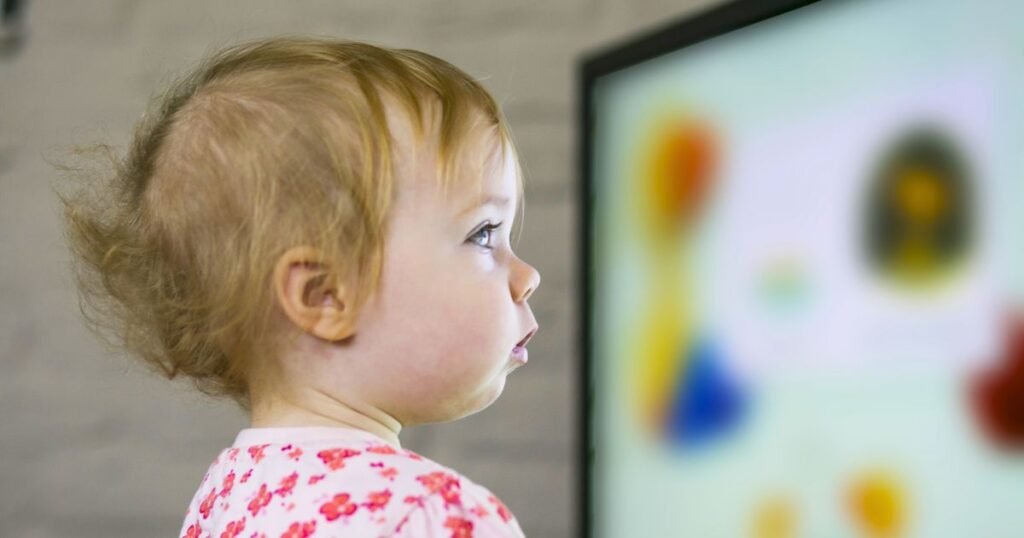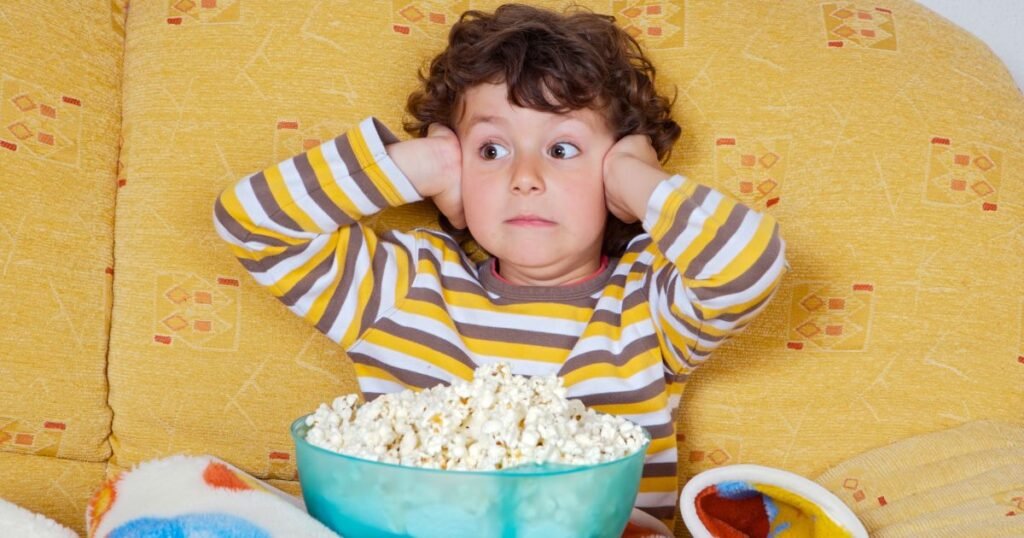Last Updated on 4 March 2024
UPDATED 4 MARCH 2024
As parents, we want the best for our little ones, especially when it comes to their screen time. While there are plenty of shows available for young children, not all of them are suitable for their cognitive development. High-stimulation shows with flashy visuals and loud noises can be overwhelming for toddlers, leading to overstimulation and difficulties in focusing. That is why low-stimulation shows for toddlers focus on simple storylines, gentle humor, and valuable life lessons, providing a calm and engaging viewing experience for toddlers. In this article, we will explore the best low-stimulation shows for toddlers and the benefits they offer for their cognitive development.
Understanding the Need for Low Stimulation Shows for Toddlers
Low-stimulation shows focus on creating a calmer viewing experience for young children. These shows avoid bright colors, loud noises, and flashy visuals that can be overwhelming for toddlers. Instead, they prioritize simple storylines, gentle humor, and lovable characters to capture and maintain the attention of young audiences. By eliminating excessive stimulation, low-stimulation shows provide children with a more soothing and engaging viewing experience. They allow young viewers to process information at a manageable pace while still offering educational content and valuable life lessons.
Toddlers are at a crucial stage of their cognitive development, and screen time can play a significant role in shaping their young minds. While screen time should be moderated, the content they consume is equally important. High-stimulation shows may grab a toddler’s attention, but they can also lead to overstimulation and hinder cognitive development.
On the other hand, low-stimulation shows play a crucial role in a toddler’s cognitive development. These shows offer educational content that is tailored to the cognitive abilities of young children. By presenting information in a calm and engaging manner, low-stimulation shows improve cognition, language development, and problem-solving skills. Additionally, the gentle humor and relatable characters in these shows promote emotional intelligence and empathy. Children also learn valuable life lessons such as friendship, kindness, and cooperation.
Best Low-Stimulation Shows for Toddlers
Now that we understand the importance of low-stimulation shows for toddlers, let us explore a diverse list of shows that offer engaging yet calming content for young audiences. From animated series to classic favorites, these shows provide a perfect choice for parents looking for quality programming that promotes cognitive development, imaginative play, and valuable life lessons.
Bluey
Bluey is an animated series that has captured the hearts of young audiences around the world. The show follows the lovable adventures of Bluey, a blue heeler puppy, and her family. Bluey’s imaginative play and charming storytelling make it a sweet show that appeals to both children and adults. This low-stimulation series emphasizes the importance of family relationships, imaginative play, and the value of simple joys in life. Through relatable and heartwarming episodes, Bluey provides young children with a delightful viewing experience that encourages creativity, problem-solving, and positive social behaviors.
Little Bear
Little Bear is a gentle and heartwarming show that follows the adventures of a young bear and his woodland friends. The show’s calm pace, soft visuals, and lovable characters make it an ideal low-stimulation choice for young viewers, especially those who love Care Bears. Little Bear offers a soothing and imaginative viewing experience, where young children can join the bear on their adventures while learning valuable lessons about friendship, sharing, and the wonders of nature.
Little Bear is a six-year-old small, curious, and imaginative grizzly bear cub who lives in the forest with his family and friends.
Franklin
Franklin is a beloved show that follows the adventures of Franklin the turtle, as he navigates life lessons, friendships, and valuable experiences. This low-stimulation series offers young viewers relatable characters, gentle humor, and positive role models. Each episode of Franklin provides valuable lessons on problem-solving, empathy, and cooperation, promoting social skills and emotional intelligence in young children.
Clifford the Big Red Dog
Clifford the Big Red Dog is a beloved character who has captured the hearts of young audiences for generations. This low-stimulation show emphasizes kindness, friendship, and positive social interactions, making it a perfect choice for young children and older children alike. Clifford offers engaging stories, gentle humor, and valuable moral lessons that encourage young audiences to explore the world with curiosity, compassion, and respect.
Based on the classic children's books by Norman Bridwell, this animated series is about a red dog who is the size of a jumbo jet.
Winnie the Pooh
The New Adventures of Winnie the Pooh captures the essence of the beloved bear and his friends’ adventures in the Hundred Acre Wood. This low-stimulation series offers gentle humor, whimsical adventures, and heartwarming tales perfect for young children. The New Adventures of Winnie the Pooh provides young children with a comforting and entertaining show that sparks their imaginations and nurtures their emotional development.
Winnie-the-Pooh is a good-natured, yellow-furred, honey-loving bear who lives in the Forest surrounding the Hundred-Acre Wood.
Curious George
Curious George, the lovable little monkey, has been delighting young audiences for years with his curious nature and mischievous adventures. This low-stimulation show follows the curious monkey and his friend, The Man with the Yellow Hat, as they explore the world around them. Curious George is known for its educational content, gentle humor, and positive messages, making it a great choice for young viewers. With its simple and colorful animation, Curious George keeps toddlers engaged without overstimulating them, while teaching valuable lessons about curiosity, problem-solving, and friendship.
CURIOUS GEORGE is an animated series based on the popular books by Margret and H.A. George is a good little monkey who is always very curious"
Guess How Much I Love You
Guess How Much I Love You is a heartwarming show based on the popular children’s book. This low-stimulation series features beautiful animation, a soothing soundtrack, and heartwarming stories of love and friendship. Following the adventures of Little Nutbrown Hare and Big Nutbrown Hare, Guess How Much I Love You teaches young audiences the value of love, the joy of exploration, and the importance of expressing their feelings. With its sweet and gentle storytelling, Guess How Much I Love You offers a low-stimulation show that engages young children’s hearts and nurtures their emotional development.
Guess How Much I Love You follows the story of two hares, Big Nutbrown Hare and Little Nutbrown Hare.
Doc McStuffins
Doc McStuffins is a beloved show that follows the adventures of a young girl who can “fix” toys with her magical stethoscope. This low-stimulation series promotes valuable life lessons about empathy, kindness, and problem-solving. Doc McStuffins presents young children with relatable characters, gentle humor, and age-appropriate content that engages their minds without overwhelming them. By watching Doc McStuffins, young audiences learn the importance of taking care of others, embracing diversity, and using their imaginations.
A magical animated series about a six-year-old girl, Doc McStuffins, who has the ability to talk to and heal toys and stuffed animals!
Potential Impacts of Overly Stimulating Shows
While low-stimulation shows offer numerous benefits for toddlers, it is important to understand the potential impacts of overly stimulating shows. High-stimulation shows, with their bright colors, loud noises, and flashy visuals, can lead to overstimulation in young children. These shows can also contribute to behavioral changes such as aggression or avoidance of certain activities, making it hard for parents to manage their child’s behavior. Understanding the potential impacts of overly stimulating shows is crucial for parents to provide a balanced media consumption experience for their little ones.
Signs of Overstimulation in Toddlers
overstimulation in toddlers can manifest in various ways. Signs of overstimulation include restlessness, irritability, short attention spans, and difficulty in focusing. Bright colors, loud noises, and intense visual stimuli can leave toddlers feeling overwhelmed, leading to restlessness and irritability. Overstimulated toddlers may show increased frustration or emotional outbursts. Physical symptoms like eye strain or headaches could also indicate overstimulation.

Recognizing these signs of overstimulation can help parents create a media consumption environment that supports their toddler’s cognitive development and emotional well-being.
How to Manage Overstimulation in Toddlers
To manage toddler overstimulation, it is important to create a balanced media consumption routine and provide opportunities for physical activity. Limiting screen time and opting for low-stimulation shows can help reduce overstimulation. Engaging in physical activities, such as outdoor play or imaginative play, can help toddlers release energy and promote cognitive development. Creating a calm and quiet environment, and minimizing distractions and noise, can also alleviate overstimulation. Encouraging breaks during screen time and providing a routine that balances active and quiet playtime can further support the management of toddler overstimulation.
Transitioning to Low-Stimulation Shows
Transitioning to low-stimulation shows can be a positive step for parents looking to provide a more balanced media consumption experience for their toddlers. These shows offer a calmer and more educational alternative to high-stimulation content. Introducing low-stimulation shows gradually allows children to adjust to the slower pace and simpler storylines, while still engaging their minds. By making intentional choices about the shows children watch, parents can help foster cognitive development, imaginative play, and valuable life lessons through screen time in front of the TV. This can be a great opportunity for parents to bond with their children and introduce them to educational content while they are in front of the TV.
Steps to Introduce Low-Stimulation Shows
Introducing low-stimulation shows to your toddler can be a gradual and intentional process that promotes healthy media consumption habits. Here are some steps to consider:
- Start by selecting shows with simpler storylines and relatable characters.
- Create a cozy viewing environment with minimal distractions.
- Watch the shows together and discuss the themes and messages portrayed.
- Gradually decrease exposure to high-stimulation content while increasing low-stimulation alternatives.
- Encourage active participation and critical thinking during screen time, such as asking questions or relating the content to real-life situations.

















